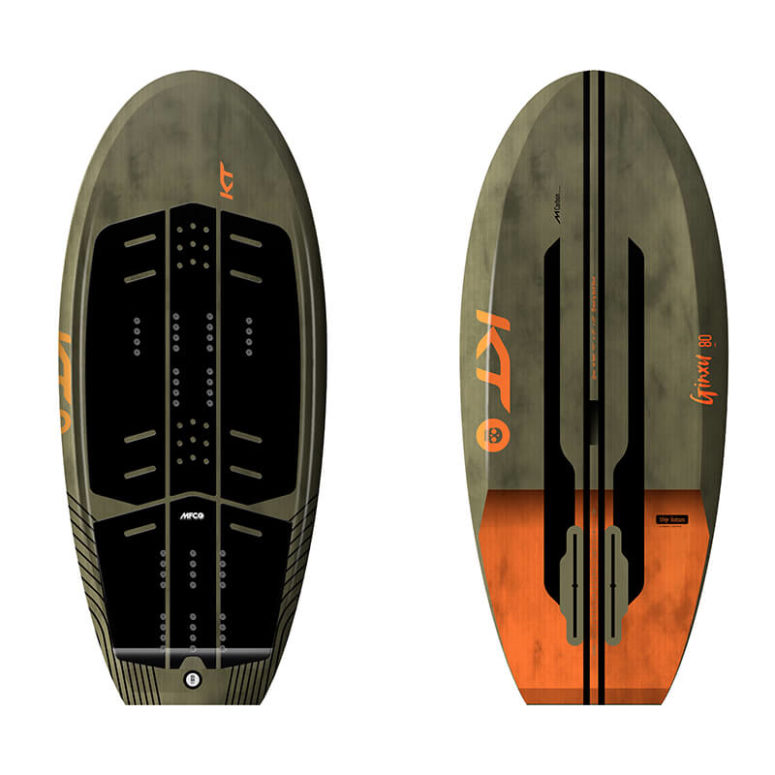

When you purchase gear through links on our site, we may earn a small commission. Here’s why you can trust our tests and our affiliate partner.

Okay, so I’m not going to deny that it’s a bit daunting when the board that Kai Lenny has been raving about lands in the hands of the test crew here at Foiling Magazine. On the plus side, you know that Kai has been absolutely shredding on it, so it definitely works! So you can treat that as a ‘real world’ appraisal of the board…
The Ginxu (if you are wondering how to pronounce that then check out the man-behind-the-board Keith Teboul talking us through it at the AWSI!) has certainly turned a lot of heads since it arrived on the scene. Why? Well take a look at the pictures. From the bottom it’s only really two thirds of a board… It was interesting hearing about how the KT crew went about testing prototypes in the tech-development crucible of Maui – boards hidden in board bags and then whisked away well offshore or to secret spots to be tested out. It truly is a completely different approach to foilboarding…
So, on to the board… The Step Bottom is the striking feature and is what sets it apart from everything else in the market. The intention of this is simple: to bring the mast of the foil closer to your back foot, thus ensuring a more responsive and connected riding experience. In doing this, the KT team also realized that this means that once you are up on the Ginxu, your mast is effectively always flying as those top couple of inches are always out of the water. We’ll come onto whether this works shortly, but the biggest challenge with this concept is the construction. Through stepping up the tail in such a pronounced way, you are effectively building-in a massive weak point on the board… After a lot of busted prototypes, with Keith’s heritage in building bombproof windsurf boards, and with some top-end materials they have arrived at a formula that they were happy with (and were happy to warranty!). The Ginxu is light too, the 62l we had on test weights in at 6.16kg.
In terms of the plan shape, the Ginxu is ‘compact’ but retains the surf-inspired outline that you find across the KT range – it’s wide in the middle but the nose and tail come in to ensure maximum forgiveness in the surf and in landing maneuvers in choppier conditions. The MFC deck grip is super comfortable to ride and not overly-cushioned, adding to the well-connected feel.
On the water and – back to the real world – we had the 62l on test which – in marginal conditions – required knee. This would not be the case in the larger sizes, but one obvious challenge with this smaller board is that without the surface area of the back 1/3 of the board, the Ginxu rides very ‘nose up’ when getting going on your knees and is pretty wobbly. This took some getting used to but was doable and, once you are on your feet and the board begins tracking, it is all good.
As soon as the board begins to generate some speed the benefits of this design are evident: it just wants to fly! The foil feels more engaged, and just as you are ready to give it a couple of little pumps to get it going, it takes off on its own. There is clearly an earlier lift than with other wingboards – it is a bit disconcerting at first but once you have attuned into it, it basically feels like you have a turbo that engages as soon as you get up to riding speed, and you are off with zero effort…
Cruising around on the board feels good – you are closer to the foil and more tuned in – but for regular riders it is not going to feel significantly different to a ‘standard’ board. The real difference is felt when you come back down onto the board – as the foil doesn’t ever completely touch down you have this strange sensation of being on the water, but still on the foil, and when it comes to coming back up on the foil this requires minimum effort – the board pops up with no stickiness and you are up and riding again. It’s a totally different sensation, and we liked it. For transitions, or for coming off a wave, you just have much more confidence that the board is not going to ‘bog down’ and that you can allow yourself a little touch down and the board will just take off again right away.
We tested the Ginxu from a complete ‘winging’ perspective (we’re looking to test a smaller size in the surf) and can say that – even though the sport is in its early years – this does feel like a true innovation that benefits the winging experience for all riders, not just the Kai Lennys of this world… AH
